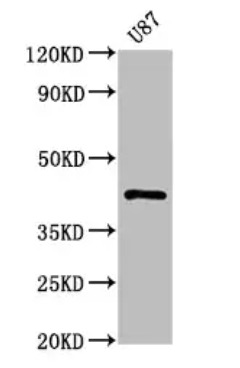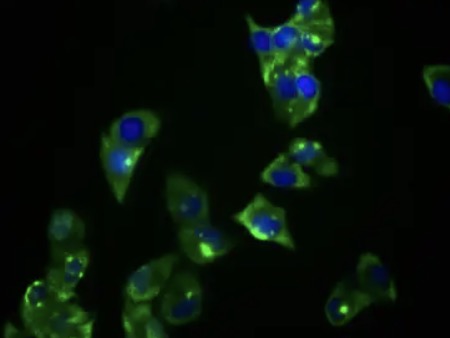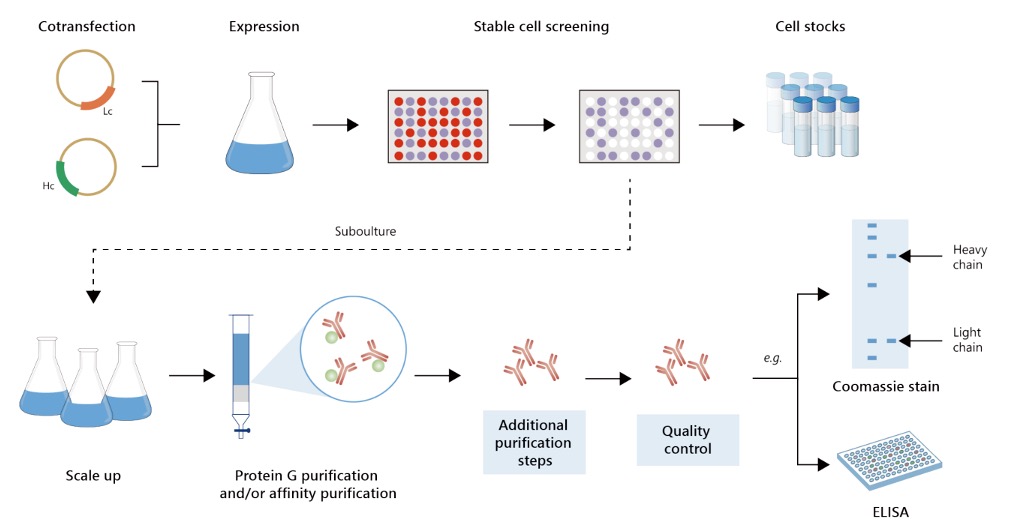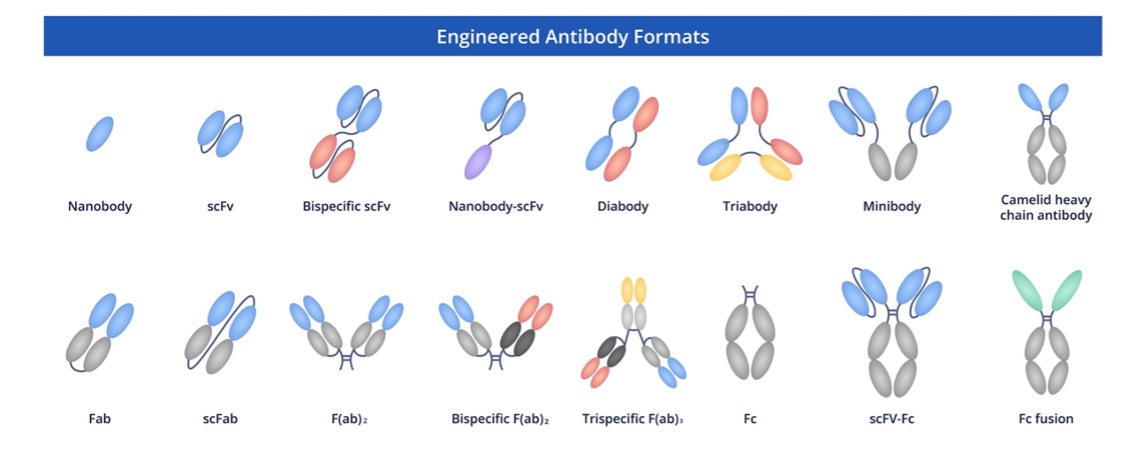 Loading...
Loading...

Anti-PRKAR1A Recombinant Antibody Products
 Loading...
Loading...Anti-PRKAR1A Products
-
- Derivation: Mouse
- Species Reactivity: Human
- Type: Mouse IgG1
- Application: WB, ICC, IF, IHC
-
- Species Reactivity: Human
- Application: Dot, WB
-
- Species Reactivity: Human
- Type: Rabbit IgG
- Application: ELISA, WB, IF
-
- Species Reactivity: Human, Rat
- Type: Rabbit IgG
- Application: WB
- AbPlus™ Anti-PRKAR1A Magnetic Beads (VS-0724-YC1145) (VS-0724-YC1145)
-
- Target: PRKAR1A
- Target Species: Human
- Application: IP, Protein Purification
- Anti-Mouse PRKAR1A Immunohistochemistry Kit (VS-0525-XY5679)
-
- Species Reactivity: Human, Mouse, Rat
- Target: PRKAR1A
- Application: IHC
-
- Derivation: Phage display library screening
- Species Reactivity: Mouse, Rat, Human
- Type: IgG
- Application: WB, IP
- Anti-PRKAR1A Immunohistochemistry Kit (VS-0325-XY1747)
-
- Species Reactivity: Human, Mouse, Rat
- Target: PRKAR1A
- Application: IHC
- Anti-Human PRKAR1A Immunohistochemistry Kit (VS-0525-XY5678)
-
- Species Reactivity: Human
- Target: PRKAR1A
- Application: IHC
Can't find the products you're looking for? Try to filter in the left sidebar.Filter By Tag
Our customer service representatives are available 24 hours a day, from Monday to Sunday. Contact Us
For Research Use Only. Not For Clinical Use.
Creative Biolabs can help you target your endocrinology and cancer genetics research with highly specific anti-PRKAR1A recombinant antibodies. PRKAR1A is a key Type 1 alpha regulatory subunit of PKA and a bona fide tumor suppressor. Inactivation of this protein is the primary cause of the rare genetic disease, Carney complex. Our top quality antibodies are the tools you need to study this unusual genetic syndrome, and to elucidate the basic mechanisms of cAMP signaling.
PRKAR1A: A Tumor Suppressor in the PKA Pathway
Protein Kinase CAMP-Dependent Type I Regulatory Subunit Alpha (PRKAR1A) is a major Type I regulatory subunit of the PKA holoenzyme. In the absence of cAMP, PRKAR1A tightly binds to and holds the two PKA catalytic subunits in an inactive state. On binding of cAMP to PRKAR1A, the two catalytic subunits are released and activated. In addition to its classical role in signal transduction, PRKAR1A functions as a bona fide tumor suppressor. Germline inactivating mutations of PRKAR1A cause Carney complex, a multiple neoplasia syndrome characterized by spotty skin pigmentation, myxomas (particularly of the heart), and a number of endocrine tumors. Loss of PRKAR1A leads to chronically high, cAMP-independent PKA activity and causes unrestrained cellular proliferation.
Alternative Names
cAMP-dependent protein kinase type I-alpha regulatory subunit; Tissue-specific extinguisher 1; TSE1; PRKAR1A; PKR1; PRKAR1; TSE1
Background
cAMP is a second messenger involved in many cellular functions. cAMP mediates its cellular effects by activation of the cAMP-dependent protein kinase which in turn transduces the signal by phosphorylation of diverse target proteins. The inactive holoenzyme is a tetramer of 2 regulatory and 2 catalytic subunits. cAMP causes the dissociation of the inactive holoenzyme to a dimer of regulatory subunits bound to 4 cAMP and 2 free monomeric catalytic subunits. Four distinct regulatory subunits and three catalytic subunits have been identified in humans. This gene is one of the regulatory subunits. This protein has been shown to be a tissue-specific extinguisher and down-regulates the expression of 7 liver genes in hepatoma x fibroblast hybrids. Mutations in this gene result in Carney complex (CNC). This gene can be involved in a gene rearrangement where it fuses to the RET protooncogene and create the thyroid tumor-specific chimeric oncogene known as PTC2. A nonconventional NLS has been found for this protein which could suggest a role in DNA replication via the protein serving as a nuclear transport protein for the second subunit of the Replication Factor C (RFC40).
Cancer-related genes, Disease related genes, Human disease related genes, Metabolic proteins, Plasma proteins
Intracellular
Cell type enhanced (Cardiomyocytes)
Low immune cell specificity
Low cell line specificity
The inactive holoenzyme is composed of two regulatory chains and two catalytic chains. Activation by cAMP releases the two active catalytic monomers and the regulatory dimer. Interacts with PRKACA and PRKACB (PubMed:33058759). PRKAR1A also interacts with RFC2; the complex may be involved in cell survival. Interacts with AKAP4. Interacts with RARA; the interaction occurs in the presence of cAMP or FSH and regulates RARA transcriptional activity. Interacts with the phosphorylated form of PJA2. Interacts with CBFA2T3 (By similarity). Interacts with PRKX; regulates this cAMP-dependent protein kinase. Interacts with C2orf88/smAKAP; this interaction may target PRKAR1A to the plasma membrane. Interacts with AICDA.
Anti-PRKAR1A rAb Products
Our Creative Biolabs anti-PRKAR1A recombinant antibodies are engineered for maximum specificity and performance. They are carefully validated to specifically detect the R1-alpha subunit in a variety of tissues. Optimized for your key applications such as Western Blot to verify loss of protein expression in tumors and IHC to visualize its expression pattern, our rAbs are designed to give you the consistency and confidence you need to move forward with your cancer genetics research.
Table 1. Featured anti-PRKAR1A recombinant antibody products at Creative Biolabs.
| Cat. No. | Product Name | Target Species | Host Species | Applications |
| ZG-0521U | Rabbit Anti-PRKAR1A Recombinant Antibody (clone 1C3) | Human | Rabbit IgG | WB, IF, ELISA |
| MOB-2272z | Mouse Anti-PRKAR1A Recombinant Antibody (clone 18F5) | Human | Mouse IgG1 | WB, ICC, IF, IHC |
| MOB-1296CT | Recombinant Mouse anti-Human PRKAR1A Monoclonal antibody (4657D3b) | Human | Mouse IgG | WB, DB |
Creative Quality Control
At Creative Biolabs, we do not compromise on scientific integrity. The production of our anti-PRKAR1A recombinant antibodies is guided by a robust quality control program. Each lot is rigorously tested for purity and specificity to other PKA regulatory subunits, as well as consistent performance in validated applications.
 Fig.1 WB analysis of anti-PRKAR1A antibody
Fig.1 WB analysis of anti-PRKAR1A antibody
(Cat# ZG-0521U, Creative Biolabs)
 Fig.2 IF analysis of anti-PRKAR1A antibody
Fig.2 IF analysis of anti-PRKAR1A antibody
(Cat# ZG-0521U, Creative Biolabs)
Customer Reviews

Rabbit Anti-PRKAR1A Recombinant Antibody (clone 1C3)
rAb Production
At Creative Biolabs, we are committed to serving the scientific community by providing antibodies to target key areas of endocrinology. Our state-of-the-art production platforms enable us to make a diverse portfolio of antibodies. Our anti-PRKAR1A recombinant antibodies are expressed in optimized systems to ensure that they recognize the native protein with the highest specificity, and provide you with an active tool for your experiments.
Featured Anti-PRKAR1A Recombinant Antibody Production Platforms
Fig.3 Milligram-scale anti-PRKAR1A recombinant antibody production.
 Fig.4 Gram-scale anti-PRKAR1A recombinant antibody production.
Fig.4 Gram-scale anti-PRKAR1A recombinant antibody production.
rAb Modalities
Creative Biolabs is dedicated to providing the scientific community with antibodies in a variety of customizable formats to empower your research. Our anti-PRKAR1A recombinant antibodies are available in a variety of modalities to allow you to design the perfect experiments to investigate this important tumor suppressor.
 Fig.5 Full-length anti-PRKAR1A recombinant antibody production and modalities.
Fig.5 Full-length anti-PRKAR1A recombinant antibody production and modalities.
Uncover the mechanisms behind PKA dysregulation in disease with Creative Biolabs' validated, highly specific anti-PRKAR1A recombinant antibodies. Our portfolio of rigorously validated antibodies can help you tackle Carney complex and dissect the roles of cAMP signaling. We have the antibodies you need to get your work done. Talk to our scientific team today.



